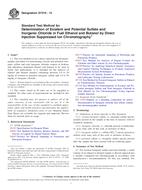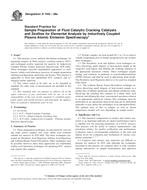Potrebujeme váš súhlas na využitie jednotlivých dát, aby sa vám okrem iného mohli ukazovať informácie týkajúce sa vašich záujmov. Súhlas udelíte kliknutím na tlačidlo „OK“.
ASTM E2224-10
Standard Guide for Forensic Analysis of Fibers by Infrared Spectroscopy
Automaticky preložený názov:
Štandardné Sprievodca pre forenznú analýzu vlákien infračervenou spektroskopiou
NORMA vydaná dňa 15.9.2010
Informácie o norme:
Označenie normy: ASTM E2224-10
Poznámka: NEPLATNÁ
Dátum vydania normy: 15.9.2010
Kód tovaru: NS-44711
Počet strán: 5
Približná hmotnosť: 15 g (0.03 libier)
Krajina: Americká technická norma
Kategória: Technické normy ASTM
Kategórie - podobné normy:
Anotácia textu normy ASTM E2224-10 :
Keywords:
fibers, forensic science, infrared spectrophotometry, Sulfar fibers, UV comparison microscopy, Vinal fibers, Vinyon fibers, Forensic investigation/analysis, FTIR analysis, Infrared spectrophotometry, Infrared spectroscopy, Lastrile fibers, Microscopical infrared analysis, Novoloid fibers, Nytril fibers, Polycarbonate fibers, Fluorocarbon fibers, Acrylic fibers, Anidex fibers, Fiber analysis, ICS Number Code 07.140 (Forensic science), 71.040.50 (Physicochemical methods of analysis)
Doplňujúce informácie
| Significance and Use | ||||||||
|
Fiber samples may be prepared and mounted for microscopical infrared analysis by a variety of techniques. Infrared spectra of fibers are obtained using an IR spectrophotometer coupled with an IR microscope. Fiber polymer identification is made by comparison of the fiber spectrum with reference spectra. Consideration should be given to the potential for additional compositional information that may be obtained by IR spectroscopy over polarized light microscopy alone (see Microscopy Guidelines). The extent to which IR spectral comparison is indicated will vary with specific sample and case evaluations. The recommended point for IR analysis in a forensic fiber examination is following visible and ultraviolet (UV) comparison microscopy (fluoresence microscopy), polarized light microscopy, and UV/visible spectroscopy, but before dye extraction for thin-layer chromatography. This list of analytical techniques is not meant to be totally inclusive or exclusive. The following generic types of fiber are occasionally encountered in routine forensic examinations: Anidel, Fluorocarbon, Lastrile, Novoloid, Nytril, Polycarbonate, PBI, Sulfar, Vinal, and Vinyon. Exemplar data, reference standards, or examiner experience, or combination thereof, may be inadequate for characterization of these fibers by optical microscopical and microchemical techniques. For these fiber types, IR spectroscopic confirmation of polymer type is advisable. Because of the large number of subgeneric classes, forensic examination of acrylic fibers is likely to benefit significantly from IR spectral analysis (11). Colorless manufactured fibers are lacking in the characteristics for color comparison available in dyed or pigmented fibers. The forensic examination of these fibers may, therefore, benefit from the additional comparative aspect of IR spectral analysis. If polymer identification is not readily apparent from optical data alone, an additional method of analysis should be used such as microchemical tests, melting point, pyrolysis infrared spectrophotometry, or pyrolysis gas chromatography. Infrared analysis offers the advantage of being the least destructive of these methods (12). |
||||||||
| 1. Scope | ||||||||
|
1.1 Infrared (IR) spectrophotometery is a valuable method of fiber polymer identification and comparison in forensic examinations. The use of IR microscopes coupled with Fourier transform infrared (FT-IR) spectrometers has greatly simplified the IR analysis of single fibers, thus making the technique feasible for routine use in the forensic laboratory. 1.2 This guideline is intended to assist individuals and laboratories that conduct forensic fiber examinations and comparisons in the effective application of infrared spectroscopy to the analysis of fiber evidence. Although this guide is intended to be applied to the analysis of single fibers, many of its suggestions are applicable to the infrared analysis of small particles in general. 1.3 The values stated in SI units are to be regarded as standard. No other units of measurement are included in this standard. |
||||||||
| 2. Referenced Documents | ||||||||
|
Podobné normy:
Historická
1.1.2012
Historická
1.5.2013
Historická
1.12.2012
Historická
1.9.2008
Historická
1.2.2014
Historická
1.9.2009



 ASTM D7183-12
ASTM D7183-12 ASTM D7319-13
ASTM D7319-13 ASTM D7343-12
ASTM D7343-12 ASTM D7442-08a
ASTM D7442-08a ASTM D7515-09(2014)..
ASTM D7515-09(2014).. ASTM D7550-09
ASTM D7550-09
 Cookies
Cookies
